A Light Green Light: Toward Sustainability in Practice
Installation by Sabrina Raaf
Curated by Steve Dietz
gallery@calit2
April 2 - June 4, 2010
Documentation
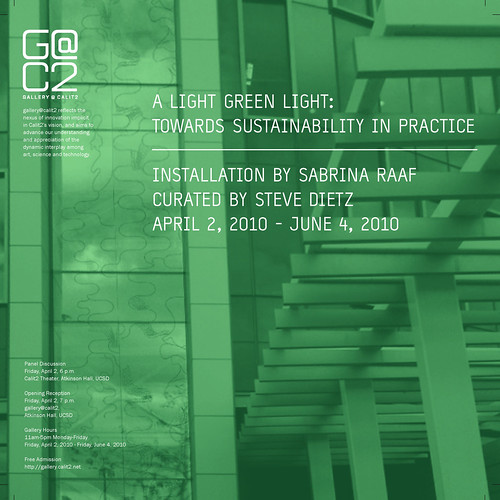
Toward Sustainability in Practice
by Steve Dietz
I first experienced one of Sabrina Raaf's works, Saturday, at the 2004 ISEA in Tallinn, Estonia. To listen to Saturday, which is a mix of surveilled conversations from a neighborhood park, you don't put on headphones, you put on a glove. The glove has a bone transducer in it, which transmits the audio by touching your forehead.
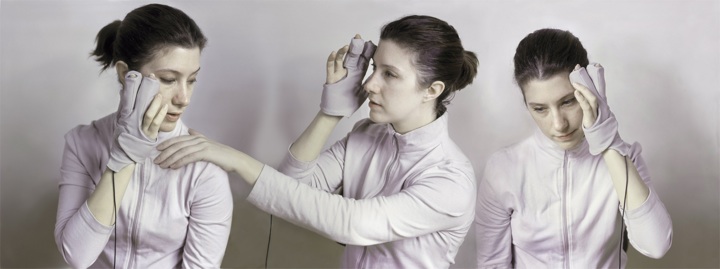
I remember being amazed at the time, when I realized I was listening through my fingers. It was magic. Prestidigitation. But as I listened to the conversations - snatches of drug deals and amorous entreaties and errands to run before coming home - the interface became increasingly sensical, almost inevitable. It was a sleight of hand that distracted me from the fact of the theft of the conversations. It made physical the virtual communications in the ether surrounding us, which, even if they are apparently invisible, are subject to being caught. And whether they would end up in benign hands could not be guaranteed. But what the interface never became, despite its sophistication, was about the technology.
I experienced this same blend of nerdy, magical, glamorous, righteous pragmatism when I first met Sabrina in the summer of 2009. In a quiet voice that was conspiratorial only in the sense that it assumed I understood what she was talking about, she explained her plans for what was to become Meandering River, and Hans-Henrik Stolum's1996 article "River Meandering as a Self-Organization Process" [pdf]. Of course, I knew it, I nodded. Photographs and diagrams of Poulsen lamps transmogrified into mosquito netting via origami sites and a particular NASA video she had recently found. "Inspirations" for the work ranged from high tech jewelry to an illuminated umbrella powered by rain to a virtual tensegrity site by SodaPlay. Her dew harvesting proposal for (n)-fold was based, in part, on the experience of the International Organization for Dew Utilization as well as Ned Kahn's Articulated Cloud for the Pittsburgh Children's Museum.
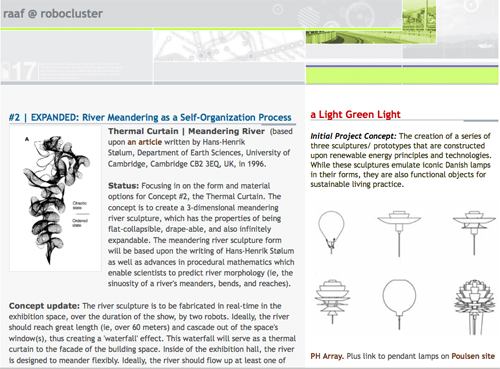
In other words, Sabrina's sources ranged far and wide from academic journals on the environment and robotics to real-world solutions - or at least experiments - by the hobbyist and the well-funded lab alike to the inter-penetrating worlds of art, architecture, design, craft, and engineering. Her joy in her topic(s) of choice as well as the rigor with which she approached them was contagious.
Sustainable Practice
There are many different ways to understand "sustainability in practice," but perhaps the baseline requirement is "sustained inquiry." It is not redundant to say that in order for a practice to be sustainable, it must be sustained. Sustainability is not just an end point, it is a daily, ongoing long-term practice, in "sickness and in health," that "neither snow nor rain nor heat nor gloom of night" can stay, so to speak. I suppose this can be viewed as a hopelessly naive and romantic view of the artist, more akin to starving in one's garret than being an actor in a network or an economic agent or a researcher among researchers, but I think the evidence of Sabrina's practice over many decades, which is by no means unique, is that it is sustained. The issue of how to continue to make it so is not just economic or even existential, it is ecological.
The "science of relationships between organisms and their environment" is how Sabrina quotes Ernst Haeckel as defining ecology, and when I say that the issue of a sustainable practice is ecological, I don't just mean that it is about the environment, as noble and as important as such a cause might be. Sabrina's practice, like any artist's, can only be sustained - and understood - as relational to an unruly set of fields of knowledge and practical expertise. It cannot and should not be defined solely in the context of art or "new media," whatever that is, or art and technology or computation or environmental studies or agriculture or CNC systems or space or river morphology or robotics or public health or origami. Sabrina's practice is a sustained inquiry into and between and among.
Light Green Light, of course, does encompass a particular set of five artworks, which have differing but not unrelated relationships to a particular set of ideas, which can be understood, perhaps, as sustainability in the environmental sense.
Practicing Sustainability
Sabrina continues to make work that does not directly address environmental sustainability issues, such as her recent Curtain Wall (2009), in which a hanging sculptural environment "recreates the facade of the McCormick Place West building and bends it's structure until it takes on the form of a pliable curtain, blowing in the wind." As with Translator II: Grower, which is in the Light Green Light exhibition, Curtain Wall is an environmental work in that it is a responsive environment. As Sabrina writes about it
"In keeping with the original meaning of the Windy City moniker (based upon blustery politics and politicians), the virtual 'glass curtain' shown in the video reacts to voice levels (both in their pitch and volume) by actively fluttering, floating, or flapping. The more 'wind' visitors create with their voices the more motion is generated in the curtain."

In the broadest sense, Curtain Wall is an ecological work highlighting and playing with the relationships between organisms and their environment, but it is not in any direct sense about the sustainability of the natural-human environment.
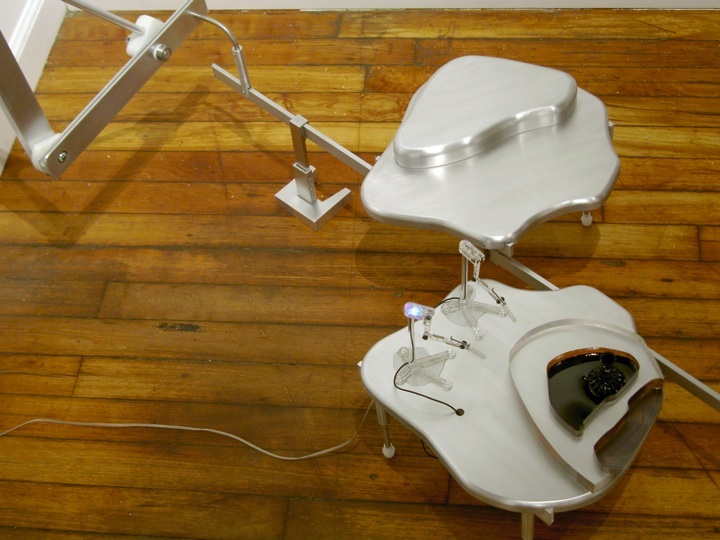
With her Icelandic Rift (2006-2007) series, Sabrina did/does directly/indirectly deal with issues of environmental sustainability by encouraging the viewer to speculate with her about not only how agriculture - and mineral extraction? - might happen in a zero gravity environment but why. Over population? Nuclear holocaust? Economic enrichment? Divorce? As with much challenging - and sustaining - artwork, the motivation is left up to the viewer. Iceland Rift is a platform as much for the human imagination as agricultural experimentation.
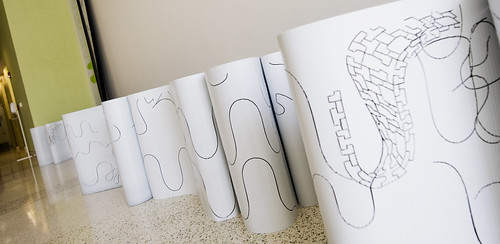
What is distinguishing - and challenging - about the new series of works that includes Meandering River, n-(fold), and Light Green Light is that while they retain a speculative aspect like Icelandic Rift, the speculation is more pragmatically experimental. How best to thermally insulate a constructed environment. How best to create a rainwater catchment system for arid environments. How best to design "a lamp that could do more than just light, but that could also unpack into a flexible, minimalist living environment."
It is the criteria for "best" that interests me. Along with saving the world, of course. Why a meandering river pattern for the transpiration of the thermal screens? Why high-end Danish designs for the look of the dew harvester and lamp-net? The easy answer, I suppose, is that they look good. A beautiful marriage of design and functionality. But I'm not buying it. Isn't there something more?
Probing Practice
The artist duo Dunne + Raby, in their practice and teaching emphasize critical design as a form of research, not to make "better" products but as often as not to explore contemporary society by designing imagine-able products, "launching them," and studying the results (see Dunne + Raby, Design Noir: The Secret Life of Electronic Objects). It is this probing of the ecology of organisms' - us - relationship to their environment that Sabrina's work shares with Dunne + Raby and many others. Light Green Light, the exhibition, is about the human-natural environment, yes. It is about sustainability in a world of excess and need, yes. But at its core, it is about sustaininig a practice that sends out beautiful probes to provoke a reaction by us to our environments - large and small, universal and personal - which in turn affects the environment of the artist, who is already practicing her next probe.
Practice. Practice. Practice. |